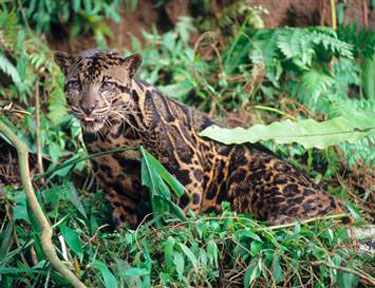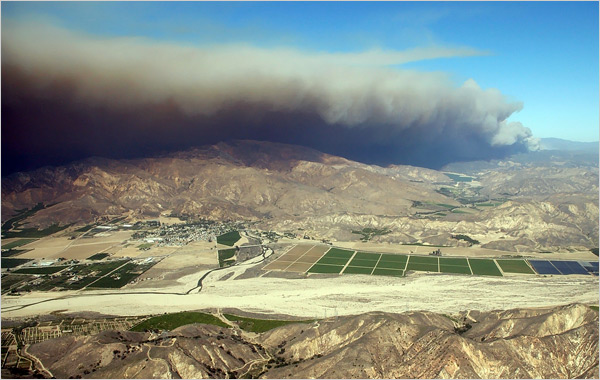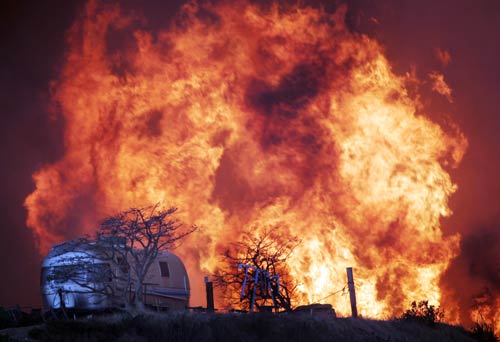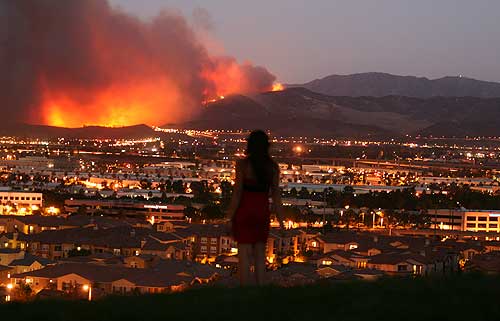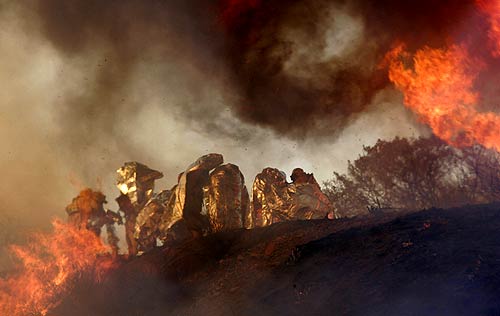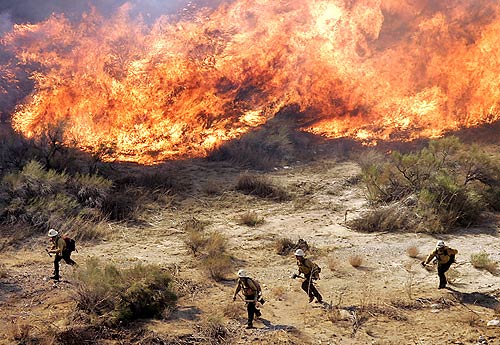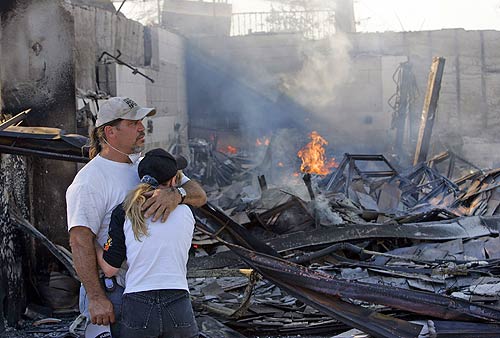Diary - October 2007
John Baez
October 1, 2007
On
September 9th I wrote about the bad effects of
plastic trash. Here's another story on that:
October 2, 2007
Today I flew to the
Deep Beauty
conference at Princeton.
In the Denver airport, I bought a National
Geographic magazine. It was quite good, better than in the old days.
I enjoyed the short article about a new species of clouded leopard
discovered in Borneo. Online, I can only find an earlier
article on the same subject:
People believe there are 5,000 to 18,000 of these
Bornean
clouded leopards, many in a mountainous rain forest called the Heart
of Borneo. Despite their name and appearance, they are not closely related to
true leopards. They live in trees and are very agile: they can descend
tree trunks head-first, and even climb while hanging upside-down
from a branch! They probably hunt by dropping down on their prey,
but this has not been seen: they're quite elusive.
Except for bats,
new
mammal species are hard to find
nowadays. But the Bornean clouded leopard is not a new find! It
was first noted by Western zoologists in 1823. At the time it
was considered a separate species, Neofelis diardi.
It was later reclassified as a subspecies of the
clouded
leopard
Neofelis nebulosa
, which is found in southern China,
the eastern Himalayas, north-east India and south-east Asia.
However, in December 2006, genetic analyses convinced scientists that the
Bornean clouded leopard is actually a separate species.
You can tell the mainland clouded leopard looks different:

But looks don't prove much. Genes matter more,
and a molecular clock estimate says that the Bornean clouded leopards
separated from their mainland kin 1.4 million years ago, after they
used a land bridge to reach Borneo and Sumatra. Now they're different
enough to be a separate species.
Someday, I hope not too late, people will regard each Bornean
clouded leopard as a work of art more precious than any
masterpiece by Monet or da Vinci. Beautiful and more
irreplaceable than any mere work of man, it has been
honed through eons of natural selection, almost perfectly
adapted to its environment — until we showed up.
Now all the rules have changed. Now it survives only
with our forbearance.
The World-Wide
Wildlife Federation is
trying to save 220,000 square kilometers
of the Heart of Borneo.
I support them, and I hope you do too.
If you're not in love with the Bornean clouded leopard yet, watch this:
I don't know if the clouded leopards are related to the
Asian leopard cat.
Here's another article I enjoyed:
Since we visited Singapore and Malacca in the summer of 2005,
and Lisa has gotten job feelers from the National University of Singapore,
it's not just a love of exoticism that makes me interested
in the pirates that ply their trade in the Strait of Malacca. I'm not sure I'd
want to take a cruise near Singapore, given the high rate of
piracy
nearby! Check out the International Maritime Bureau
maps showing
pirate
attacks worldwide — you'll see a lot concentrated around
Malaysia and Indonesia.
The National Geographic also
had a good article on the comparative merits of
different biofuels:
Click on the boxes here to compare biofuels.
Or if you just want the executive summary:
-
Ethanol from corn sucks. But that's what the US is subsidizing,
thanks to the muscle of big agribusiness.
-
Biodiesel is better.
-
Sugar-cane ethanol is even better, as long as you don't tear down
rainforests to grow it. That's what Brazil is doing.
(See my June 15, 2005
entry for more.)
-
Making ethanol from cellulose or biodiesel from algae could
be even better — but these technologies are still under
development.
But the best article of all was this:
The really cool part is a chart that
Robert
Socolow and
Stephen
Pacala made up in this paper:
It lists 15 measures, each of which could reduce
carbon emissions by 1 billion tons per year by 2057. Here's
an executive summary of what they claim:
-
If we
adopt 12 of these measures, we could lower our carbon emissions from
the current figure of 8 billion tons per year to 4 billion tons per
year by 2057.
This might mean 450 parts per million of CO2 in the
atmosphere by this time, and a global temperature rise of 2° C
(or 3.6° F).
With this, we could still expect coastal flooding that affects millions
of people per year. Cereal crop yields will tend to decrease in low
latitudes. And up to 30% of species might face the risk of
extinction, with most coral reefs being bleached. But this is the
"good" scenario.
-
If adopt only 8 of the measures, we could hold our carbon emissions
constant at the current figure of 8 billion tons per year. This
might mean 525 ppm of CO2 in the atmosphere, and a
global temperature rise of 3° C (or 5.4° F). With this,
we can expect the widespread death of coral reefs. We can also
expect the bad consequences listed above, and: 30% of coastal
wetlands being lost, with most ecosystems becoming carbon sources
as permafrost thaws and vegetation burns or rots.
-
If we adopt none of the measures, we can expect carbon emissions
to double by 2057, to 16 billion tons per year. This might mean 800 ppm of
CO2 in the atmosphere, and a global temperature rise
of 5° C (or 9° F). With this, we can expect that more than
40% of species will face extinction. We can also expect the
bad consequences listed above, and cereal crop yields decreasing in
some mid- to high-latitude regions.
Here are the 15 measures, which Pacala and Socolow
call "wedges":

I should do my part for wedge 2 and stop flying to so many
conferences.
Of course I'll also vote against Bush in the next
election — or at least whomever he supports.
October 7, 2007
I'm back from the conference
Deep Beauty:
Mathematical Innovation and the Search for an Underlying
Intelligibility of the Quantum World, organized by
Hans
Halvorson of the Princeton University philosophy department.
Here are some of the
participants at von Neumann's grave, in a picture taken by Jamie
Vicary — who therefore remained invisible himself, alas:
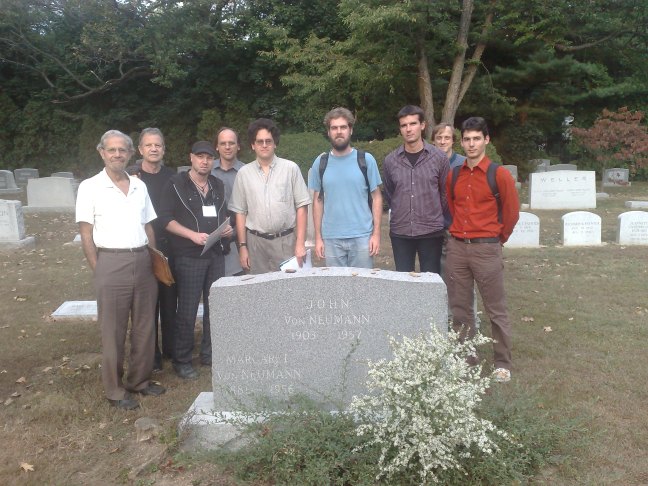 From left to right: Simon Kochen, Jeffrey Bub, Bob Coecke, Peter Woit,
John Baez, Mike Stay,
From left to right: Simon Kochen, Jeffrey Bub, Bob Coecke, Peter Woit,
John Baez, Mike Stay,
Andreas Döring, Camm Maguire and Chris Heunen.
The honor of being the "keynote speaker" (woo-hoo!) was almost
completely balanced by
the inconvenience of it all. First of all,
the conference took place for two days in the middle of the week:
the first full week of class here at UCR. Second, the trip there
was a nightmare.
On Tuesday morning I caught a shuttle to Ontario airport at
5:15 am. My 8 am flight with United was cancelled, so I wound up
sitting in the airport until 11:40 am, flying to Denver, sitting
around for a couple of hours, and arriving at Newark airport after
midnight. I made it to the Nassau Inn at 1:30 am and went to bed around 2.
I got up at 8:30, slurped down some coffee and inhaled a bagel,
and gave my talk on Spans in Quantum Theory at 9:30.
I hate giving talks when sleep-deprived or jet-lagged. I can still
fight my way through them, but the fine-tuned sense of "nailing it"
— of saying everything the best way, with drama and a sense of
humor — is gone. Luckily, this time, despite the punishing trip,
I was feeling quite peppy when I gave my talk, perhaps because I'd
slept a lot on the plane. So, I nailed it, finished early, and
enjoyed a nice long question-and-answer period afterwards. Later that day
I sort of crashed.
The conference was funded by the Templeton Foundation. It
was one of a series of conferences at Princeton this week, whose
ostensible purpose was to honor the 75th anniversary of von Neumann's
book The Mathematical Foundations of Quantum Mechanics, but were also timed around a Templeton Foundation board meeting at
held at Princeton. The Templeton Foundation is controversial among
scientists for its support of religion and especially its funding of the
the Discovery Institute, which promotes
"intelligent design". However, in my indirect dealings with them — both
at this conference and in my work for the Templeton-funded Foundational Questions Institute —
I've never heard anyone even mention religion.
I hope to write more about this conference in This Week's Finds.
October 8, 2007
Today Thomas Riepe passed on an interesting article about a World
Bank study on the "intangible capital" that citizens of rich countries have
access to:
Bailey asks:
When a Mexican, or for that matter, a South Asian or African, walks
across our border, they gain immediate access to intangible capital
worth $418,000 per person. Who wouldn't walk across the border in
such circumstances?
The World Bank study is here:
October 9, 2007
At the end of my June 28th
diary entry I mentioned how Craig Venter's team had succeeded in
giving a bacterium a complete genome transplant. I said "Of course
this is 'cheating' in at least two senses: it uses an already
functioning cell, and it uses the genome of an existing bacterium. The
fun will start when they put in a novel, human-crafted genome."
The fun is starting! Mike Stay points out this article:
The key part:
The Guardian can reveal that a team of 20 top scientists assembled by Mr
Venter, led by the Nobel laureate Hamilton Smith, has already constructed a
synthetic chromosome, a feat of virtuoso bio-engineering never previously
achieved. Using lab-made chemicals, they have painstakingly stitched together
a chromosome that is 381 genes long and contains 580,000 base pairs of
genetic code.
The DNA sequence is based on the bacterium
Mycoplasma
genitalium
which the team pared down to the bare essentials needed to support life,
removing a fifth of its genetic make-up. The wholly synthetically
reconstructed chromosome, which the team have christened
Mycoplasma
laboratorium, has been watermarked with inks for easy recognition.
It is then transplanted into a living bacterial cell and in the final
stage of the process it is expected to take control of the cell and in
effect become a new life form. The team of scientists has already
successfully transplanted the genome of one type of bacterium into the
cell of another, effectively changing the cell's species. Mr Venter
said he was "100% confident" the same technique would work for the
artificially created chromosome.
Of course the new chromosome has not been designed ab initio,
but it's very sensible to start by modifying an existing chromosome.
Let's see if they're right about it having all the "bare essentials
needed to support life". They may have left something out. People
may be just figuring out why we have an
appendix, for example.
October 10, 2007
I bumped into a poem by Rumi that sent chills up my spine:
If you want what visible reality
can give, you are an employee.
If you want the unseen world,
you are not living your truth.
Both wishes are foolish,
but you'll be forgiven for forgetting
that what you really want is
love's confusing joy.
And, the new Radiohead album is out:
In Rainbows. You've probably
heard about it, since everyone is talking about it —
but some of you, my friends, are far removed from
the whirl of pop culture, so I thought I should mention it.
It's caused a big stir, since it's available
online
for a price you get to choose yourself, plus a $1 service fee.
Right now their website is so busy I can't get through.
They're not saints. They're doing it for good economics reasons:
and they'll make a lot of money off this, as well as creating a
lot of good publicity, which will help them when signing their
next contract with a record company (if they choose to do that).
But, I like the idea a lot.
October 11, 2007
I'm not sure I believe this story Mike Stay pointed me towards.
It reminds me of variou episodes of unreliable Russian and
Soviet science — like polywater, Kirlian photography and
those Soviet military projects to harness paranormal abilities.
But it'll be really cool if it's true:
I assume you know about the Chernobyl disaster.
This article says
Ekaterina
Dadachova
and Arturo
Casadevall
of the Albert Einstein College of Medicine
have found two species of fungi in the entombed Chernobyl reactor
—
Cryptococcus
neoformans and
Wangiella dermatitidis —
that contain lots of melanin.
Melanin
is a name for a variety of chemicals, including those that
give you a tan: they protect against ultraviolet light.
However, Casadevall and Dadachova claim these
fungi use melanin to obtain energy from
gamma rays, much as plants obtain energy from light using chlorophyll!
The actual paper is here:
As far as I'm concerned, the key finding is this:
Melanized Wangiella dermatitidis and
Cryptococcus neoformans cells exposed to ionizing radiation
approximately 500 times higher than background grew significantly faster
as indicated by higher CFUs, more dry weight biomass and 3-fold greater
incorporation of 14C-acetate than non-irradiated melanized cells or
irradiated albino mutants. In addition, radiation enhanced the growth
of melanized Cladosporium sphaerospermum cells under limited
nutrients conditions.
They're getting energy from radiation! Hmm — could it be not
the gamma rays themselves that do the job, but instead lower-energy
radiation (X-rays or ultraviolet) produced by or accompanying the gamma rays?
Let's see. They zapped the fungi with radiation from a
caesium-137
source, which puts out 662 keV gamma rays. That's a wavelength
of only 2 picometers, while hard X-rays go down to 10 picometers.
So, these are honest gamma rays. People even use them to sterilize
things! But, I don't know what such gamma rays
do when they hit the culture or container the fungi are in. Maybe
they produce lower-energy radiation.
They also tried infrared, visible light, and ultraviolet, and they all
helped the fungi grow about equally well! So, maybe melanin gets easily
ionized by all sorts of radiation — I don't know the physics
of melanin.
Lisa went to Shanghai tonight... she'll be gone for about a week.
October 13, 2007
Did you hear about the meteorite that landed near a
small town in Peru on September 15th? The reports are quite confusing
and contradictory. People saw something fall from the sky, ran
over and found big hole full of water.
Some say the water
was boiling at first. Some say the cause was a meteorite, while others
say it was an American satellite or just a pre-existing lake.
Some say that hundreds fell ill from strange fumes, possibly from
arsenic in the water. Others say this was a case of mass hysteria,
or that only a few people got sick.
An early BBC report was pretty dismissive:
However,
later
reports seem to confirm that a meteorite indeed
hit the earth — a rocky meteorite called a
chondrite,
in fact.
You can see a video
of the scene.
(I thank James Dolan for telling me about this meteorite. I didn't
hear about it at the time.)
It took me a long time to love Brian Eno's album The Drop.
I just realized I actually do.
Eno is always pushing the limits
of music. Unfortunately this means that by the time you've learned
to enjoy one thing he does, he's off doing something else.
On The Drop he forsook all the rich, subtle textures some of
his music was known for. In 1997, he went to
live in St. Petersburg for a year
and made music in his apartment. He strippped the technology down to
some cheap, almost cheesy-sounding synthesizers and drum machines.
And, he played some weird melodies that don't quite sound like
anything you've ever heard — a bit jazzy, but definitely
not jazz, a bit repetitive and minimalist, but not in any style
we're accustomed to. He called it "unwanted jazz", or "sour piano".
When I first heard this album it seemed like a cheap imitation of
the Eno I'd come to expect. But by now, I know what he's up to.
The reviews on Amazon nicely capture his fan's reactions, which were
my reactions too. Hans Stoeve writes:
He who expects never receives. This old saying has been haunting me for
awhile now and I can't help but think this is appropriate for this release.
I have listened to The Drop quite
a number of times now, and I'm left with
an empty feeling when I hear it. Now don't get me wrong. Eno is
THE reason why I am on the air, but maybe it's a good thing to look at your
old ghosts from time to time and admit that either your tastes have changed
in a big way over the years (which they certainly have), or Eno simply hasn't
come up with anything new that is worth while. What I hear are fragments of
Eno's past, fragments that include Neroli and memories of
Spinner and Shutov Assembly also. As well as
Low and Heroes.
This is almost an attempt at some sort of jazz, but
it's a sort of jazz you can't quite pinpoint and consequently you're left
feeling confused. Maybe this is the purpose of this recording. Eno has for a
long time been at the forefront of modern music. The man is a pioneer and a
genius in my book and listening to this record raises many questions for me
like: what is the purpose behind this? Where is Eno heading?
Is he quietly having a laugh at us for taking it all so seriously?
Jesse Melat writes:
With all his astounding, influential and historic albums that the man has
released, it's a mystery as to how this came about in his body of work.
Or is it? The Drop is unique in the musical territory it charts; there
isn't anything on Earth that sounds quite like it, but it just seems...
dumb in some places. "Belgian Drop" really does sound like
an amateur noodling with a Casio.
These reactions are perfectly valid, but they haven't worked
their way through to the deeper layers of the music, and they seem
to have forgotten that Eno's gift was always for making music that sounds
bad at first but great eventually — music that breaks
rules, but follows new rules that you have to discover. So, his
old stuff always sounds better than his new stuff... but not because
he's getting worse.
I think Kenneth Burstall come closer to what I'm trying to say here:
at first listening a nasty and very small CD. it seems to have no
relation to any of enos previous work and gives the impression that
he had a really bad headache during recording and decided to transmit it.
by laser. directly to you. that's why i like it - in this country (the uk)
eno is fast becoming a national treasure (consultant to big projects,
talker about future things etc). it's nice to be reminded that he's
essentially an anarchist and he will bite you if you get too close. spiky,
unsettled music. you may not like it, but it likes you in a concerned but
faintly sinister way. now stop crying.
Right now Eno has an art exhibition near San Francisco, called
77 Million Paintings.
I should have gone up to see it, but I'm too lazy. And, someday
it may appear on my TV.
October 15, 2007
It rained the night before last! And today it was foggy, moistening
the plants! If you don't live around here, you don't
know how big a deal this is. The southwest US is in an 8-year drought,
and southern California has been very dry this year.
We get water from northern California and from the Colorado River,
and both these sources are planning to cut back how much they supply
us, by 25% or so. The state government is struggling to build new
dams or other ways of storing water, but the Democrats and Republicans
have competing plans, and the legislature is in gridlock:
The little rain we just had won't help much. But, it's nice
to see. And it's very nice to be able to turn off the sprinkler system in our
garden for two days in a row!
The garden is beautiful these days — I'll have to take some
photos. I just had some soup made from an enormous kale plant we harvested.
October 17, 2007
Clearing through old papers I found scrawled notes on a dream I
had years ago; I can't remember when. I used to write down my dreams
a lot when I was in college and grad school; gradually I slacked off,
but this one comes from much later.
Riding through bog on horseback we spot two parrots ahead avoiding us.
Someone running with us decides to chase it down. He can run
superhumanly fast and keep up with a gallop. The parrot keeps
flying ahead, looking back, pausing. "If we tire it and chase it
down we can make it grant us a wish." We chase it until it tires
and falls from the sky into a pond. The man lunges after and grabs
it.
Then the parrot's husband appears to defend its mate! It dives
at me and threatens to peck and bite me. I decide to catch it, so
I resist its attacks and tire it until exhausted it gives up and
I catch it. Then we are to extract a wish.
We go to the parrot's home
and they are people, beautiful people, and there is a third beautiful
woman. I realize we have done something terribly wrong and we will
be cursed by the parrots for what we have done, and I tell everyone
in the party to apologize. Even this will not be enough, so I tell
everyone to give the parrots a gift of what they hold most dear.
Everyone does and then I realize I must too. I take a brooch of stones
strung together by beads, and take it apart, to remove the center stone,
a gift from Lisa, which I hold most dear. As I do beads and stones
fall to the ground, and they are precious but I can't trifle to try to
save all of them. I give the stone to the parrots, and then kneel sadly
to gather the stones and beads and string them together. Everyone
watches me and tries to help me find a new way, a new pattern, but
without the center stone it is a bit pathetic. Someone in my party
says that it looks much worse without the stone Lisa gave me and I
say "Of course, you fool! That's the whole point!"
I am very regretful
and I realize the only way I'll ever profit form this is that maybe if there
is ever a forest fire the birds, who have heard of us from the parrots,
will bear me aloft and save me.
Or (I picture this) when Lisa and
I have a child, and there is a forest fire, and the child is lost,
and we cannot save it, the owls will fly away with it and save it and
leave it in a secret place by the coast. Lisa and I will despair and
look everywhere (with little hope) for the child, and then find it and
know the owls have saved it.
October 18, 2007
Todd Trimble pointed me to a interesting book:
I've been a fan of Robert
Fripp's guitar work ever since I heard Exposure back in high
school.
I found the most illuminating section of this book to be chapter 10, on Tamm's
experieces in the guitar school Fripp founded. A quote:
Fripp told the story of his dozing in a friend's Chelsea loft in the early
1980s. He leapt from the sofa with a sudden realization. "Music stands at the
door and knocks," he said. "One day we hear it faintly, but by the time we get
through all the junk on our floor, it is gone. So we clean up the mess. Next
time, we answer the door and meet it, but the house has such a stench that
it goes away. Finally we set our house in order, because..." and here
Fripp did one of his long pauses, turned his eyes down to the mid-foreground,
and grew visibly grave and saddened ... "because we just couldn't bear
for it to go away and not return," these last words pronounced in a quiet,
slightly wavering voice. It took him a few minutes to recover from
the thought; he appeared disoriented and shaken.
For music, substitute whatever your true calling may be.
October 20, 2007
A peaceful, slightly lonely weekend without Lisa, who'll return
(imshallah) from Shanghai very late tomorrow night. I went to the
gym today for the first time in way too long, and feel much
better for it. Then I continued trying to finish my paper
A prehistory of n-categorical physics,
for the conference proceedings I'm editing with Peter May. I'm
having a lot of trouble trying to pack all my thoughts on this subject
into one place — or figure out which thoughts to put in, and
which to leave out.
So, it's been tough weekend, though very peaceful. In the afternoon
I goofed off a bit composing some electronic music, which didn't turn
out well — perhaps because music doesn't want to be used as
a form of procrastination.
I also wrote a reply to Sean Carroll's challenge for people to
say what "God" means. Normally I avoid public pronouncements on
religion, since they tend to be tacky. But I think this challenge misses
the point in a fundamental way: it pushes the whole discussion down to
a debased level (which of course is the level where most public discussions of
religion reside). And, I felt an urge to say why... which
I will probably regret tomorrow. But here's what I wrote, mildly
edited:
"God" means many things to many people. But to me — just me — "god"
is a desperate attempt to take the awesome inexhaustible mystery of the
universe — the fact that the deeper you go in any direction, the
more you find — the blinding beauty and heart-rending tragedy of
it all — and package it into a kind of "thing".
In my work I often experience this sense of awesomeness, of depths that
pass beyond my understanding. In fact, that's what I live for.
But I don't find it helpful to package it into a "thing". After all,
this strange "thing" can't be a normal sort of thing in the universe,
so it's easy to conclude it's either in some other universe (say,
"heaven"), or doesn't exist at all, or exists in some very tricky
sense. But all these alternatives are just distractions, as far as
I'm concerned.
So for me, saying that god "does not exist" is just as silly as saying
that god "does exist". They both take me further from the mystery of
the universe into the realm of petty squabbles.
But, if we imagine that certain — not all — people talking
about "god" are actually trying to convey an experience of the hair-raising
awesomeness of reality, its shattering majesty, some things they say might
make more sense. To take a few examples just from Christian theology:
No one has seen or can see God. (John 1.18)
He lives in unapproachable light. (1 Timothy 6:16)
The true knowledge and vision of God consists in this: in seeing that
He is invisible, because what we seek lies beyond all knowledge,
being wholly separated by the darkness of incomprehensibility.
(Gregory of Nyssa)
God is infinite and incomprehensible and all that is comprehensible
about Him is His infinity and incomprehensibility. (John of Damascus)
These examples were all lifted from an Orthodox website on
apophatic
theology, known more generally (among Christians anyway) as
negative
theology. Negative theology is a pretty good
way to convey the mystical experience that underlies
some of the less rotten aspects of religion — though keeping cool and
not talking about it at all may be wiser. "Whereof one cannot
speak, thereof one must be silent."
I chose Christian examples because the Anglocentric
"culture wars" Carroll's blog are engaged in involve
Christianity more strongly than other religions: they're
largely a political battle between secular humanists and
fundamentalist Christians in the United States (though Dawkins
is British). But, I have no special affinity to Christianity, and
if I were just looking for "negative theology" quotes, it'd be easier
to find them elsewhere, often in traditions where "theology" is not
even a concept. For example:
The way that can be trodden is not the enduring and
unchanging way.
The name that can be named is not the enduring and unchanging name.
- Tao Te Ching
Santa Ana winds are blowing into town tonight. The broom
hanging on the wall outside keeps knocking...
October 21, 2007
The Santa Ana winds are still blowing, and fires are spreading
throughout Southern California. The year-long drought, the
worst in recorded history, has dried all the brush to make perfect kindling.
Now we have winds blowing at speeds exceeding 80 kilometers per hour (50 mph).
The biggest fires are west of us, near the coast:
So far there are no fires here in Riverside County, and
the skies looked blue today except for windblown dust near the horizon.
But, there are now three fires in
neighboring San Bernardino County. Quoting the Riverside
Press-Enterprise:
The largest was 300 acres near Interstate 15 in Fontana. One vacant home was
destroyed and 500 homeowners were told they should evacuate. The second
blaze had burned about 30 acres near the junction of Interstate 15 and 215
in Devore. Five to 10 homes were threatened. Another fire had chewed through
35 acres south of the highway junction and winds were blowing between
50 mph and 80 mph, officials said.
Our house has a pretty good bunch of iceplant on the hill behind
it, which is designed to protect us when the dry parkland in back
catches on fire. But, we've got a wooden trellis out back. So,
I'm always on the alert when these Santa Ana winds come —
and especially this year, with everything bone-dry.
I'm happy that the world in general is getting wetter
as global warming proceeds. This won't cheer up residents of
Bangladesh. I'm just happy because around here,
it's not true — so I sometimes get the horrible feeling
the whole world is drying out, burning up and turning into a desert.
The American southwest is getting drier... but in general, more
warmth means more water vapor, so more rain.
Mark Muckenfuss
Riverside Press Enterprise, October 21, 2007
[...]
In fact, of the top 10 largest fires in California's recorded history, seven have taken place in the past 20 years. The most recent was this summer's Zaca Fire (240,000 acres) east of Santa Barbara.
Contributing to Troubles
Experts say several factors are involved.
Decades of fire suppression have left forests overgrown. In earlier times, such growth would have been limited by periodic low-grade fires. In recent years, efforts have been made to reduce the excess vegetation by letting remote fires burn and conducting controlled burns, but neither strategy is practical in Southern California's densely populated mountains.
Climate change has increased the length of the fire season, drying fuels out earlier, keeping them dry for longer and leading to fires of greater intensity.
The periodic drought cycle in which the region finds itself has exacerbated those conditions, as has a bark beetle infestation that's killed millions of trees.
With increasing numbers of homes bordering wildland areas, when a fire does break out, more resources are focused on saving structures, making it harder to contain other areas of the fire.
There is some disagreement as to the degree of importance of these factors, but most experts agree that each plays a part.
Richard Minnich is an earth sciences professor at UCR. He says environmental factors are much more important than the efforts of firefighters.
"We're good at putting out little fires," Minnich says. "Once a fire is large, all that knowledge has trivial influence. We have no ability to control large fires any more than we can control earthquakes."
It wasn't until a cold front moved in during the fires of 2003, bringing rain and snow, that firefighters were able to contain the blazes.
Battling Big Blazes
Minnich says few gains have been made in fighting large wildland fires.
"In practice, I don't see any difference between now and 1950," he says, "except that you have bigger and bigger planes and the fires are getting bigger."
The problem he says, is the forest, which was once able to regulate itself, has an overabundance of vegetation.
"There is some historical evidence to support that Southern California used to look like what we see presently in Baja (California)," says Minnich.
There, the chaparral environment supports fewer and more widely spaced trees.
Because of periodic natural fires, he says, the terrain is a checkerboard of areas with varying degrees of vegetation. When a fire does start in an area with sufficient fuel, he says, it usually burns itself out once it reaches an area with less vegetation.
This can take awhile. Historic data indicates that before the 20th century, fires in Southern California would sometimes burn for months before extinguishing themselves, Minnich says.
Back then, when there were few homes in the foothills and mountains, such fires weren't a problem.
But the San Bernardino National Forest is now home to 100,000 residents and is the country's most densely populated forest. The presence of so many homes has necessitated policies of fire suppression. Populated areas limit the ability of fire managers to conduct controlled burns that would thin heavy fuels and, when fires do erupt, protecting those homes presents firefighters with greater challenges.
People, and the way they have changed the local landscape, are the greatest factor in bigger fires, says Stephen Pyne, a professor of American studies at Arizona State University and an expert in fire history.
"I think there is a tendency to attribute to global warming the increase in fires," Pyne says. "It is a precondition, but it is not enough to explain it.
"We know that we broke the cycle of (natural) fires by introducing livestock and by removing American Indians who, the evidence suggests, burned very widely," he adds.
Recent removal of more than 1 million trees killed by a bark beetle infestation in the San Bernardino mountains have helped thin the vegetation. But Minnich says it is not nearly enough.
"The people in Lake Arrowhead and Idyllwild need to start thinning seriously," he says. "They need saw mills in both places."
Lumber processing facilities are operating in the forest, but they primarily deal with trees killed by the bark beetle. Minnich believes commercial lumber mills are needed to turn live trees into lumber.
Some experts argue that climate change is the primary driver in the phenomenon of larger fires.
Connie Millar studies climate and ecology for the U.S. Forest Service.
"I think the underlying feeling within the firefighting community (is) the growing realization of the increasing role of climate," Millar says.
Climate Shifts
A study published last year in Science magazine connected earlier snowmelt and the later onset of winter weather to an increase in the size and intensity of fires.
"It was finally the coming out of the closet, as it were," says Millar. Before the study, she says, "The agency had been more in the mode of assuming land-use changes were the primary (factor)."
Tony Westerling, professor of environmental policy at UC Merced, co-authored the study with Tom Swetnam, a watershed management professor at the University of Arizona. Swetnam is scheduled to appear tonight in a "60 Minutes" story on global warming on CBS.
The two scientists looked at historical data on fires and climate.
They defined two periods, 1970-1986 and 1987-2003, and found the number of fires in the second period was four times what it was in the first and a six-fold increase in the number of acres burned. The researchers also found that since 1986, the length of the active fire season — when fires are actually
— increased by 78 days.
Now it's 9:25 pm and there about 13 fires in Southern California.
A nasty one is overrunning the city of Irvine, on the coast:
A new one just started up in Ontario, about 50 kilometers from
my house over in San Bernardino county.
I'm hoping the high winds
don't stop Lisa's flight from landing in Los Angeles airport —
she's supposed to arrive there around 9:50 pm.
9:30 pm. Yay! Lisa called; her plane has landed.
In the town of Canyon Country there's a fire 5000 hectares
in area (12,500 acres), and wind-blown embers are flying up to 3
kilometers. The winds are picking up, and they'll blow even faster
tomorrow — with gusts up to 130-145 kilometers per hour (80-90 mph)!
Luckily, from all these fires, only one person has died so far.
October 22, 2007
It smells smoky outside, and I can see the haze. The wind
died down overnight, but now it's picking up a bit.
You can see a map of the fires here.
None around here yet, luckily.
October 23, 2007
It's not windy here in Riverside, and there are no fires.
The air is a bit smoky, but that's the only sign of the huge
battles going on nearby.
October 24, 2007
As winds lessen throughout Southern California,
firefighters may start to get the upper hand. The worst
is probably over now. But, the Santiago fire (in Orange
County, near the coast) and the fire near Lake Arrowhead (up in the mountains
north of us) remain out of control.
The fires have been worst down in San Diego, where the Witch Fire has forced
evacuations of almost a million people.
Amazingly, there have been no
fires here in Riverside County. It wasn't windy at all yesterday.
Now the breeze is picking up.
I smell smoke, but the sky is mostly blue.
On a wholly different note:
a while back Lisa spoke to the Rene Lysloff, who runs the gamelan
here at UCR. I've been doing some electronic music lately. He suggested the
WinChime program
for making random wind chime music, and the
Ableton Live
and Sound Forge software for serious recording. I'll have to check these
out...
Guess what's the biggest segment of the Italian economy.
October 25, 2007
Here's the situation as of this evening:
October 27, 2007
We had David and Michelle Scharffenberg over for dinner.
They live up near Lake Arrowhead, between two of the big fires,
and that whole area has been evacuated, with police preventing
people from driving back up. Their two cats, Noggin and Newton,
are stuck up there.
Amazingly, it rained a little this evening! Not much,
just a drizzle, but it's a great change. On the other hand, the
"onshore flow" (wind coming from the sea) is blowing smoke
back here, and the Santiago fire is burning right up to the
Riverside county line, so the air is much more polluted
here now.
October 29, 2007
Yesterday was hot and dry, but today it's cloudy again with a
chance of rain.
In the end, global warming presents the greatest test we
humans have yet faced.... It's our coming-of-age moment, and there
are no certainties or guarantees. Only a window of possibility,
closing fast but still ajar to let in some hope.
- Bill McKibben
© 2007 John Baez
baez@math.removethis.ucr.andthis.edu
